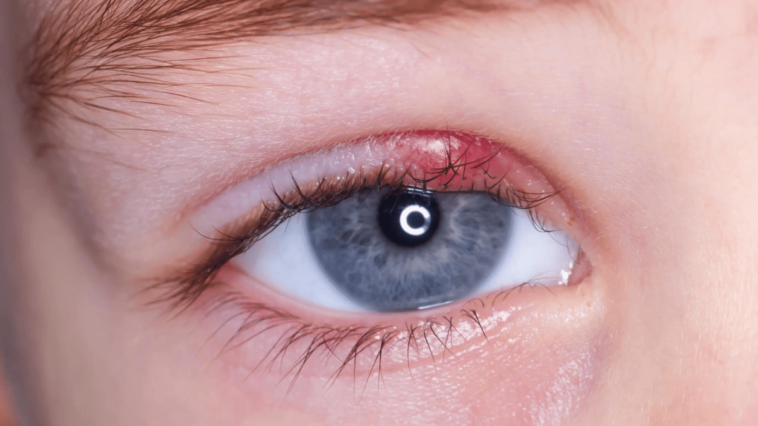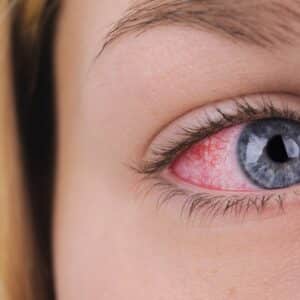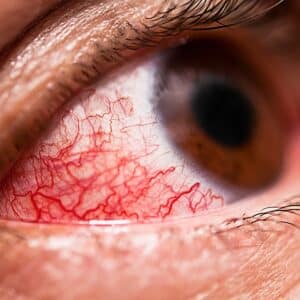What is an Eye Stye?
An eye stye is a bacterial infection of the eyelashes or small sebaceous glands near the eyelashes’ base. It appears as a bump filled with purulent liquid at the edge of the eyelid, surrounded by an eyelash.
While it can be painful and bothersome, an eye stye doesn’t typically lead to blurry vision or decreased sight. The risk of contagion is very high, so it’s essential to practice good hygiene and avoid rubbing your hand over both eyes after touching one.
Types of Eye stye?
What are the two types of Eye Stye? An Eye Stye is an infection caused by bacteria called Staphylococcus aureus, found in the nose and can be transferred to the eye when one rubs their nose.
A stye typically occurs at the base of an eyelash or in one of the small sebaceous glands on the eyelid. It usually manifests itself as inflammation or infection of the follicle.
There are two types of Eye Stye:
- External, which is located at the base of an eyelash.
- Internal occurs within one of the small sebaceous glands on the eyelid.
Eye Stye Symptoms
An eye stye, also known as a hordeolum, is an infection caused by bacteria that can form on your eyelid.
Symptoms of an eye stye include :
- Pain and tenderness around the affected area
- Redness and swelling of the eyelid,
- Small, red bump similar to a pimple,
- Discharge or pus coming from the bump,
- The feeling of pressure on the lid,
- Difficulty opening the eye due to discomfort.
If you are experiencing any of these symptoms, it is recommended that you see an eye doctor for diagnosis and treatment.
What Causes Eye Stye?
What causes an eye stye? An eye stye is usually caused by a bacterial infection of the eyelid gland that can be brought on by various factors such as:
- Poor hygiene habits can lead to a higher risk of developing a stye. This includes not washing your face or hands regularly and needing to remove makeup properly.
- Dry eyes: Eye styes are caused by dry eyes, which can occur due to lack of tear production, contact lens overuse, or exposure to irritants
- Exposure to hormonal fluctuations, such as those during menstruation and pregnancy, can increase the risk of developing a stye. Hormones can alter the environment around the inner or outer eyelid enough to cause infection or inflammation in these areas, leading to the stye.
- Eyelid irritation, such as from rubbing your eyes or wearing irritating makeup, can increase the chances of developing a stye. Styes are often caused by clogged oil glands around the lashes. Taking steps to reduce eye irritation can help reduce your risk of getting this painful and bothersome condition.
- Eyelid abnormalities, such as an overproduction of oil or blockage of the oil glands, can increase your risk of developing a stye.
- People with underlying conditions such as chronic diabetes or weakened immunity are more likely to develop an eye stye.
What is Eye Stye Treatment?
Eye Stye Treatment typically involves addressing the cause of the infection and reducing symptoms like inflammation and discomfort. Common treatments for an eye stye include:
- Warm compresses: Can be applied to the eyelid. To do this, soak a cloth in hot water and squeeze out any excess. Place the compress over the affected eye for 10-15 minutes at a time, up to three times per day. This helps to soften and draw out the substance causing the stye.
- Antibiotic ointment: Your eye doctor may recommend using an antibiotic or eye drops to help treat it. These can be effective in treating the infection and providing relief from pain and discomfort.
- Pain medication: Pain relief is typically the first step. Over-the-counter medications such as acetaminophen and ibuprofen can relieve pain and discomfort associated with an eye stye.
- Stye removal: Eye stye treatment may involve making a small incision in the affected eyelid to allow for drainage if the stye is significant or not responding to other treatments. This procedure, named stye removal, is reserved for cases where other treatments are ineffective and should be done by an ophthalmologist.
Are Eye Styes Contagious?
Is it possible to contract a stye from someone else? Styes are most commonly caused by bacteria found on the skin, which can also be present in other people.
Therefore, getting a stye from contacting someone else with an active stye is possible. To reduce the risk of contracting a stye, practicing good hygiene and keeping your eyes clean is important.
Are Eye Styes Caused by Stress?
Many believe that stress, anxiety, and fatigue can increase the risk of developing an eye stye. However, there is no scientific evidence supporting this notion.
In fact, experts believe that eye styes are caused by bacteria and poor hygiene rather than stress. Therefore, although stress can lead to general fatigue, which may affect one’s vision, it is likely not the direct cause of developing an eye stye.
Eye Stye: When to See an Eye Doctor?
An eye stye is a swollen bump that usually appears at the edge of your eyelid and can cause discomfort or irritation. If you are experiencing these symptoms, you should contact a medical professional to get treatment.
It’s essential to seek medical attention as soon as possible if you experience the following symptoms:
- Very severe pain,
- Your eyelid is highly swollen,
- Fever
- There is a red-eye,
- The stye persists for more than two weeks without improvement despite at-home care or recurs frequently.
- If you have an immune deficiency
- Diabetes
In some cases, a stye may be a sign of a more serious underlying condition, such as an infection or inflammation of the eye. Getting a proper diagnosis and treatment is essential to prevent potential complications.
If you are experiencing any concerning symptoms or have a weakened immune system, you must see an eye doctor as soon as possible.






